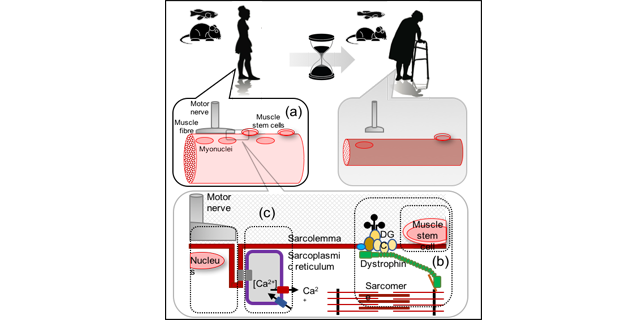Health
Biomedical translation of the Centre’s discovery biology into the clinic.
The biomedical translation of the Centre’s discovery biology encompasses the study of muscle structure, function and metabolism across diseases and conditions, particularly muscle wasting pathologies such as
- ageing (sarcopenia)
- cancer cachexia
- muscular dystrophies (particularly Duchenne muscular dystrophy and facioscapulohumeral muscular dystrophy)
- inflammatory myopathies
- intensive care unit acquired wasting
The Centre’s mechanistic focus on understanding the signalling pathways regulating muscle attributes like size and metabolism, have applications for improving human performance, enhancing safety and productivity in the workplace, and for optimising sports performance through understanding the underlying bases of muscular fatigue, muscle growth, adaptation and plasticity in response to nutritional and pharmacological interventions.
Muscle wasting conditions
The biomedical translation of the Centre’s discovery biology encompasses the study of muscle structure, function and metabolism across diseases and conditions. Particularly muscle wasting pathologies including ageing (sarcopenia), cancer cachexia, muscular dystrophies (particularly Duchenne muscular dystrophy and facioscapulohumeral muscular dystrophy), inflammatory myopathies, intensive care unit acquired wasting and other muscle-related conditions.
The Centre’s mechanistic focus on understanding the signalling pathways regulating muscle attributes like size and metabolism, have applications for improving human performance, enhancing safety and productivity in the workplace, and for optimising sports performance through understanding the underlying bases of muscular fatigue, muscle growth, adaptation and plasticity in response to nutritional and pharmacological interventions.
Ageing
Australia's population is projected to be ~38 million by 2060 – a reality of record life expectancies, but one where living longer does not mean necessarily living in better health. The Productivity Commission report ‘An Ageing Australia: Preparing for the Future’ describes how ageing will affect the economy due to changes in population, participation and productivity, affecting labour supply, economic output, infrastructure and budgets.

Consider the reality of the pension age rising to 70 by 2035 and the concomitant demands on the workforce to remain healthy and productive for longer. Addressing the physical reality of this problem depends entirely on muscle and breakthroughs in understanding the biology of ageing are needed to cope sensibly and humanely with our growing older population.
Ageing is linked with a deterioration of muscle structure and function that occurs in all animals and so preserving muscle is essential for quality of life since everyday activities and even survival is dependent on a functioning musculature.
The Centre’s complementary themes of Discovery and Engineering will be applied to understanding the biological regulators of muscle ageing, especially the cellular and molecular events that dictate muscle fibre size and adaptations to the environment.

Current Research Projects (Health)
-
Investigating the Dystrophin-Glycoprotein Complex to Protect Muscles from Wasting Conditions
Project Leader: Prof Gordon Lynch
-
Identifying factors that improve gastrointestinal function in Duchenne's muscular dystrophy
Project Leader: Prof Gordon Lynch
-
Investigating the role of cachexia in the response to surgical tumour resection in mice
Project Leader: Prof Gordon Lynch
-
Defining new roles for the Hippo signalling pathway in skeletal muscle
Project Leader: A/Prof Paul Gregorevic
-
Developing innovative animal and cell culture models to study and treat muscular dystrophies
Project Leader: A/Prof Paul Gregorevic
-
Learning from skeletal muscles to develop new treatments for cancer
Project Leader: A/Prof Paul Gregorevic